
by Nic Haygarth | 23/05/25 | Story of the thylacine
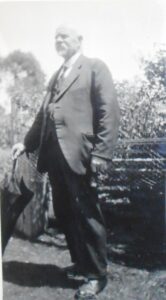
James ‘Tiger’ Harrison, Wynyard native animals dealer, snarer, prospector, track cutter, estate agent, shipping agent, Christian Brethren registrar, tourist chauffeur, human ‘cork’ and Crown bailiff of fossils. Photo from the Norman Larid files, NS1143, Tasmanian Archives (TA).
In the mid-1920s thylacines were still reported by bushmen in remote parts of the north-west. Luke Etchell claimed there was a time when he caught six or seven ‘native tigers’ per season at the Surrey Hills.[1] Like Brown brothers at Guildford, Van Diemen’s Land Company (VDL Co) hands at Woolnorth were still doing a trade in live native animals—although the latter property was out of tigers. On 7 July 1925 Hobart City Council paid the VDL Co £60 10 shillings for what can only be described as two loads of ‘animals’—presumably Tasmanian devils and quolls—recorded as being carted out to the nearest post office at Montagu during the previous month.[2] A further transaction of £30 was recorded in October 1925, when it is possible Woolnorth manager George Wainwright junior hand delivered a crate of live native animals to Hobart’s Beaumaris Zoo.[3]
James ‘Tiger’ Harrison (1860–1943) of Wynyard took his animals dead or alive. He bought and sold living Tasmanian birds and marsupials, including tigers, but also hunted for furs in winter. In July 1926 Harrison and his Wynyard friend George Easton (1864–1951) secured government funding of £2 per week each to prospect south of the Arthur River for eight weeks.[4] However, their main game was hunting: the two-month season opened on 1 July 1926.

James Harrison’s collaborators George Easton and George Smith with a bark boat used to rescue Easton at the Arthur River in 1929. Photo courtesy of Libby Mercer.

TOPOGRAPHIC BASEMAP FROM THELIST©STATE OF TASMANIA
Easton, an experienced bushman in his own right, made snares most evenings until the pair departed Wynyard on 14 July.[5] At Trowutta Station they boarded the horse-drawn, wooden-railed tram to the Arthur River that jointly served Lee’s and McKay’s Sawmills.[6] Next day, Arthur Armstrong from Trowutta arrived with a pack-horse bearing their stores, and the pair set out along the northern bank of the Arthur towards the old government-built hut on Aylett’s track.[7] However, on a walk to the Dempster Plains to shoot some wallaby to feed their dogs, Harrison injured his knee so badly that he couldn’t carry a pack. So before they had even set some snares the pair was forced to return home.[8] On their slow, rain-soaked journey they sold their stores to the Arthur River Sawmill boarding-house keeper Hayes—the only problem being delivery of said stores from their position up river.[9] While Harrison went home by horse tram and car, Easton had to help Armstrong the packer retrieve the stores.[10]
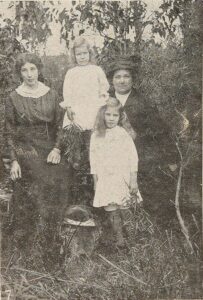
Martha Crole and her daughters. From the Weekly Courier, 10 April 1919, p.22.
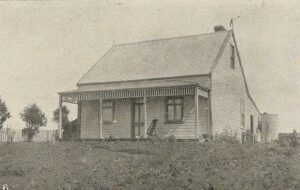
The Crole house at Trowutta. From the Weekly Courier, 10 April 1919, p.22.
‘Tiger country’ around the Arthur River
If not for the injury Harrison may have secured more than furs over the Arthur. One of the European pioneers in that area was grazier Fred Dempster (1863–1946), who appears to have rediscovered pastures celebrated by John Helder Wedge in 1828.[11] Out on his run in 1915 Dempster met a breakfast gatecrasher with cold steel. The elderly tiger reportedly measured 7 feet from nose to tail and being something of a gourmet registered 224 lbs on Dempster’s bathroom scales.[12] In dramatising this shooting, anonymous newspaper correspondent ‘Agricola’ mixed familiar thylacine attributes with the fanciful idea of its ferocity:
This part is the home of the true Tasmanian tiger … This animal must not be confounded with the smaller cat-headed species [he perhaps means the ‘tiger cat’, that is, spotted-tailed quoll, Dasyurus maculatus] so prevalent beyond Waratah, Henrietta and other places. The true species is absolutely fearless in man’s presence, and if he smells meat will follow the wayfarer on the lonely bush tracks for miles, stopping when he does and going on when he resumes his walk. It has been proved beyond question that these brutes will not shift off the paths when met by man, and they will always attack when cornered.[13]
One mainland newspaper was apparently so confused by ‘Agricola’s’ account that he called Dempster’s thylacine ‘a huge tiger cat’.[14]
Trowutta people had no problem distinguishing quoll from tiger. They caught the latter unwittingly while snaring. Fred and Martha Crole and family of Trowutta made hundreds of snares on a sewing machine, eating the wallaby meat and selling the skins they caught. One of their boys, Arthur Crole (1895–1972), landed a tiger alive in a snare, killed it, tanned the hide and used it as a bedside rug.[15] While south of the Arthur, Harrison and Easton were unlucky not to run into Trowutta farmers Fred and Violet Purdy, who caught a tiger in a footer snare there during the 1926 season. When the Purdys approached the captured animal it broke the snare and disappeared. However, tigers also frequently visited their hut south of the river at night and they saw their footprints in the mud next morning.[16] Violet Purdy claimed to have spent six months straight living in the ‘wild bush’ (the hunting season in 1926 was only July and August), and her observations of the thylacine suggest someone with at least second-hand knowledge. Like ‘Agricola’, she knew of the tiger’s reputed habit of refusing to move off a track to let a human pass. Unlike him, she attested to the animal’s shyness. Purdy recommended ‘a couple of good cattle dogs’ as the means of tracking it down. She and her husband found thylacine tracks at the Frankland River as they crossed it to reach the Dempster Plains.[17] Decades later Purdy regaled the Animals’ and Birds’ Protection Board with her tales, illustrating them with a map of ‘tiger country’ between Trowutta and the Dempster Plains.
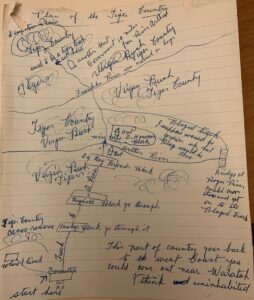
‘Tiger country’ between Trowutta and Dempster Plains, as it looked in 1926, according to Mrs V Kenevan,
formerly Violet Purdy of Trowutta. From AA612/1/59 (TA).
Snaring at Woolnorth
By the time Easton got home to Wynyard, Harrison, apparently recovered from his knee injury, had arranged for them both to snare at Woolnorth, where no swags needed to be carried, since stores were supplied. The VDL Co employed hunters every season to kill ‘game’, this serving the dual purpose of saving the grass for the stock and bringing the company income at a time of low agricultural prices. At this time hunters paid a royalty of one in six skins to the company.
Easton’s diary entries give rare insight into a hunting engagement. Harrison and Easton took the train to Smithton and caught the mail truck to Montagu, from which they were borne by chaise cart to the Woolnorth homestead. That night the snarers were put in a cottage generally reserved for the VDL Co agent, AK McGaw.[18] Next day station manager George Wainwright junior showed them their lodgings (tents next to a lagoon which served as the water supply) and how snaring (using springer snares but also neck snares along fences) and skinning were done at Woolnorth. Wainwright, an old hand, claimed to be able to skin 30 animals per hour.[19] Storms, horse leeches, which had a way of attaching themselves to the human scalp, and cutting springers and pegs kept the snarers very well occupied between snare inspections, an 11-km-long daily routine. The game was nearly all wallaby and ringtails, and Harrison and Easton dried their skins not in a skin shed but by hanging them in trees.[20] Bathing meant a sponge bath with a prospecting dish full of cold water—which also constituted the laundry facilities.[21] The last day of the season at Woolnorth was traditionally an all-in animal shoot, after which the season’s skins were baled, treated with an arsenic solution to kill insects and delivered to a skins dealer.[22] In the two-month 1926 season the VDL Co made £493 from the fur industry, a big reduction on the previous year (£1296) when the season had lasted three months.[23]
However, Harrison didn’t last the distance, calling it quits on 13 August after barely two weeks, leaving Easton to carry on alone until the season ended eighteen days later. Their skin tally at 13 August stood at 16½ dozen—198 skins or 99 apiece.[24]
Returning to ‘tiger country’
Once again ‘Tiger’ Harrison was in the wrong place at the wrong time to live up to his nickname. While he was working at tiger-free Woolnorth, timber worker, hunter and sometime miner Alf Forward snared two tigers, one alive, one choked to death by a stiff spring in a necker snare at the Salmon River Sawmill south of Smithton.[25] Forward is said to have exhibited the living one in Smithton before selling it to Harrison.[26] He almost had another live one in the following month, when a tiger detained by Forward’s snare for two days bit his capturer’s hand, thereby effecting its escape.[27]
Harrison eventually decided to cut out the middle-man. From 1927 he conducted expeditions specifically to obtain living thylacines to sell. He had no luck until in June 1929 he caught one 3 km south-west of Takone.[28] The Arthur River catchment remained ‘tiger country’ in the mid-1930s when ‘Pax’ (Michael Finnerty) and Roy Marthick claimed to have seen them while prospecting.[29] The question of whether they are there today still entertains Tarkine tourists and the worldwide thylacine mafia.
[1] MA Summers’ report, 14 May 1937, AA612/1/59 H/60/34 (Tasmanian Archives, henceforth TA).
[2 Payment recorded 7 July 1925. On 9 June 1925: ‘W Simpson taken animals to Montagu’; 22 June 1925: ‘W Simpson went to Montagu with load of animals’, Woolnorth farm diary, VDL277/1/53 (TA).
[3] Payment recorded on 13 October 1925. On 4 October 1925 George Wainwright junior and his wife departed Woolnorth for the Launceston Agricultural Show (Woolnorth farm diary VDL277/1/53). It is possible that he took a crate of animals on the train to Hobart.
[4] GW Easton diary, 1 July 1926 (held by Libby Mercer, Hobart).
[5] GW Easton diary, 1–14 July 1926.
[6] GW Easton diary, 15 July 1926.
[7] GW Easton diary, 16 July 1926.
[8] GW Easton diary, 18 July 1926.
[9] GW Easton diary, 23 July 1926.
[10] GW Easton diary, 25 and 26 July 1926.
[11] JH Wedge, ‘Official report of journeys made by JH Wedge, Esq, Assistant Surveyor, in the North-West Portion of Van Diemen’s Land, in the early part of the year 1828’, reprinted in Venturing westward: accounts of pioneering exploration in northern and western Tasmania by Messrs Gould, Gunn, Hellyer, Frodsham, Counsel and Sprent [and Wedge], Government Printer, Hobart, 1987, p.38.
[12] See for example ‘Boat Harbour’, North West Post, 22 February 1915, p.2. Dempster probably didn’t have any bathroom scales with him. Rather mysteriously, the author of ‘A huge tiger cat’, Westralian Worker, 19 March 1915, p.6, put the animal’s weight as ‘2 cwt’ (224 lbs).
[13] ‘Agricola’, ‘Farm jottings’, North West Post, 24 February 1915, p.4. In another column ‘Agricola’ claimed with equal dubiousness that under Mount Pearse trappers caught tigers in pits, and that if more than one tiger was collected in the same pit at the same time the captured animals would fight to the death. See ‘Agricola’, ‘Farm jottings’, North West Post, 10 July 1914, p.4.
[14] ‘A huge tiger cat’, Westralian Worker, 19 March 1915, p.6.
[15] Fred and Graham Crole, in Women’s stories: different stories—different lives—different experiences: a Circular Head oral history project (compiled and edited by Pat Brown and Helene Williamson), Forest, Tas, 2009, p.192.
[16] The hut was on Aylett’s Track to Balfour.
[17] Violet Kenevan, Kingswood, New South Wales, to secretary of the Animals’ and Birds’ Protection Board, 30 October 1956, AA612/1/59 (TA).
[18 GW Easton diary, 27 July 1926.
[19] GW Easton diary, 30 July 1926.
[20] GW Easton diary, 18 August 1926.
[21] GW Easton diary, 15 August 1926.
[22] GW Easton diary, 31 August and 6–9 September 1926; Woolnorth farm diary, 31 August 1926, VDL277/1/54 (TA).
[23] The figures are from VDL129/1/7 (TA).
[24] GW Easton diary, 13 August 1926.
[25] ‘Hyena choked in snare at Salmon River’, Circular Head Chronicle, 11 August 1926, p.5.
[26] ‘TT, from New Town’, ‘Tasmanian tiger’, Mercury, 24 August 1954, p.4, claimed that Alf Forward caught the animal in a kangaroo snare at the Salmon River ‘less than 30 years ago’ and sold it to Harrison after putting it on show in Smithton.
[27] ‘Hand bitten by a hyena’, Circular Head Chronicle, 29 September 1926, p.5.
[28 GW Easton diary, 17 June 1929; Circular Head Chronicle, 29 May 1929.
[29] See ‘Pax’ (Michael Finnerty), ‘A “bush-whacker’s” experience in the north-west’, Mercury, 6 May 1937, p.8; Roy Marthick to the Fauna Board, 10 February 1937 (TA); Roy Marthick quoted by Charles Barrett, ‘Out in the open: nature study for the schools’, Weekly Times (Melbourne), 10 July 1937, p.44.
by Nic Haygarth | 26/09/21 | Circular Head history, Story of the thylacine
Stephen Spurling III (1876–1962) rode the rails and marched the mountains in his quest to snap Tasmania. Revelling in ‘bad’ weather and ‘mysterious’ light, this master photographer shot the island’s heights in Romantic splendour. His long exposures of the lower Gordon River are likely to have helped shape the reservation of its banks in 1908.[1] Snow-shoed, ear-flapped and roped to a tree, he captured Devils Gullet in winter and froze the waters of Parsons Falls. But Spurling wanted to record the full gamut of life. He was there when the whales beached, the bullock teams heaved, the apple packers boxed antipodean gold and floodwaters smashed the Duck Reach Power Station. His lens was ever ready.
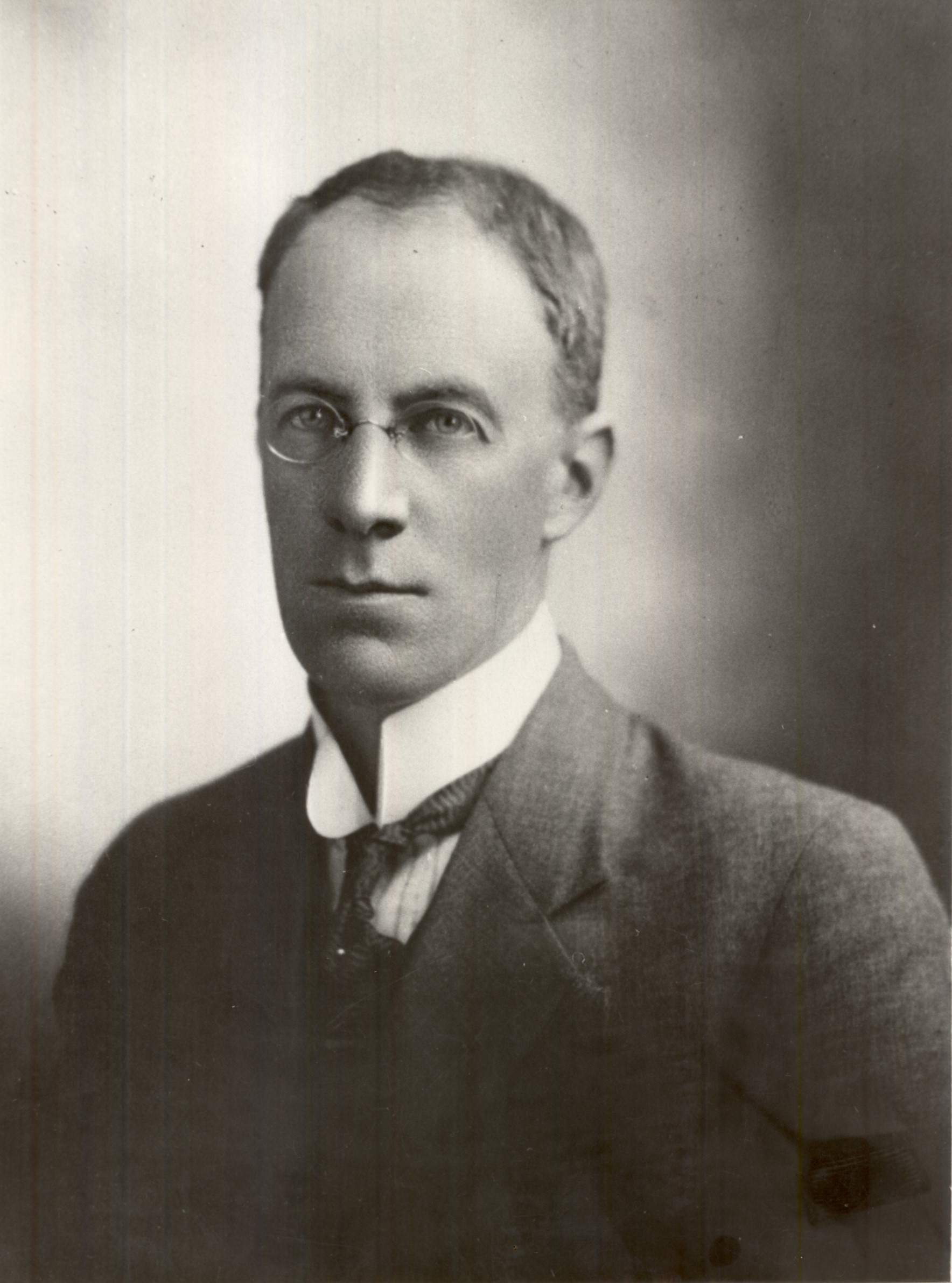
Stephen Spurling III in 1913, photo courtesy of Stephen Hiller.
Oddly, just about the only thing Spurling didn’t snap was a sack full of thylacine heads which he claimed to have seen at the Stanley Police Station in 1902. Forty-one years after the event, Spurling wrote that he watched ‘cattlemen from a station almost on the W coast [produce] two sacks of tigers’ heads (about 20 in number) and [receive] their reward’.[2] One-hundred-and-nineteen years after the event, this claim is hard to reconcile with the records of the government thylacine bounty. It adds a puzzle to the story of the so-called Woolnorth tigermen.
The Woolnorth tigermen
About 170 thylacines were killed at the Van Diemen’s Land (VDL Co) property of Woolnorth in the years 1871–1912, mostly by the company’s tigermen—a lurid title given to the Mount Cameron West stockmen. The tigermen had a standard job description for stockmen, receiving a low wage for looking after the stock, repairing fences, burning off the runs and helping to muster the sheep and cattle. They supplemented their income by hunting kangaroos, wallabies, pademelons, ringtail and brush possums. The only departure from the normal shepherd’s duty statement was keeping a line of snares across a neck of land at Green Point—now farming land at Marrawah—where the supposedly sheep-killing thylacines were thought to enter Woolnorth. The VDL Co paid their employees a bounty of 10 shillings for a dead thylacine, which was changed to match the government thylacine bounty of £1 for an adult and 10 shillings for a juvenile introduced in 1888. To make a government bounty application the tiger killer needed to present the skin at a police station, although sometimes thylacine heads sufficed for the whole skin.
It is not easy to work out how or even whether the Woolnorth tigermen generally collected the government thylacine bounty in addition to the VDL Co bounty. It is reasonable to think that the VDL Co would have encouraged its workers to do this, since doubling the payment doubled the incentive to kill the animal on Woolnorth. However, only two men are recorded as receiving a government thylacine bounty while acting as tigerman, Arthur Nicholls (6 adults, in 1889) and Ernest Warde (1 adult, 1 juvenile, in 1904).[3] This suggests that if Woolnorth tigermen and other staff received government thylacine bounties they did so through an intermediary who fronted up at the police station on their behalf.
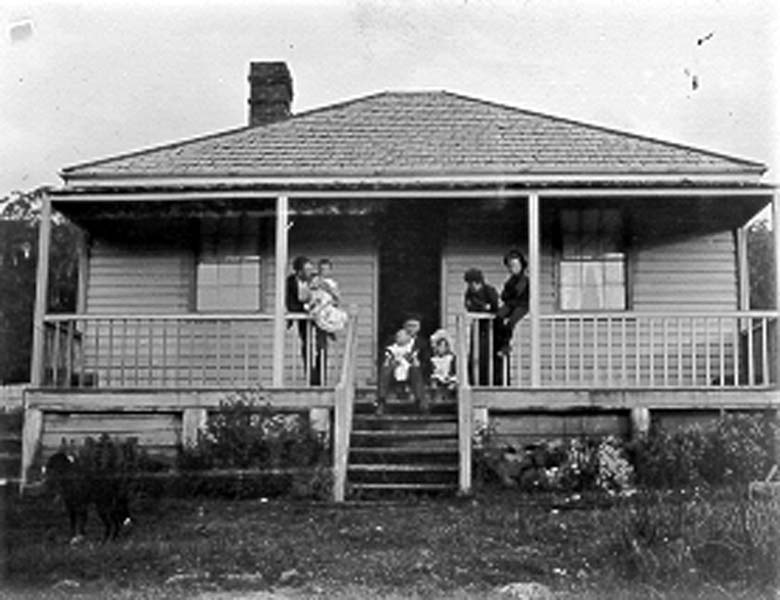
Charles Tasman Ford and family, PH30/1/6928 (Tasmanian Archives Office).
Charles Tasman Ford and William Bennett Collins
The most likely candidates for the job of Woolnorth proxy during the government bounty period 1888–1909 were CT (Charles Tasman) Ford and WB (William Bennett) Collins. In the years 1891–99 Ford, a mixed farmer (sheep cattle, pigs, poultry, potatoes, corn, barley, oats) based at Norwood, Forest, near Stanley, claimed 25 bounties (23 adults and 2 juveniles), placing him in the government tiger killer top ten.[4] If you include bounty payments that appear to have been wrongly recorded as CJ Ford (5 adults, 1896) and CF Ford (1 adult, 1897), his tally climbs to an even more impressive 29 adults and 2 juveniles—lodging him ahead of well-known tiger tacklers Joseph Clifford of The Marshes, Ansons River (27 adults and 2 juveniles) and Robert Stevenson of Blessington (26 adults).[5] After Ford’s death in September 1899, Stanley storekeeper Collins claimed bounties for 40 adults and 4 juveniles 1900–06, his successful bounty applications neatly dovetailing with those of Ford.[6]

William Bennett Collins (standing at back) and family, courtesy of Judy Hick.

WB Collins’ Stanley store, AV Chester photo, Weekly Courier, 25 February 1905, p.20.
Where did their combined 75 tigers come from? The biggest source of dead thylacines in the far north-west at this time was Woolnorth. Twenty-six adult tigers were taken at Woolnorth in the years 1891–99, and 44 adults in the years 1900–06, making 70 in all. Tables 1 and 2 show rough correlations between Woolnorth killings and government bounty claims made by Ford and Collins. Ford, for example, received 7 payments 1892–93, the same figure for Woolnorth, while in the years 1894–97 his figure was 13 adults and theirs 16. Similarly (see Table 2), Collins claimed 16 adult and 4 juvenile bounties in 1900, a year in which 22 adult tigers were killed at Woolnorth; while in 1901 the comparative figures were 17 and 9. (Some of the data for Woolnorth is skewed by being recorded only in annual statements, which makes it look as though most tigers were killed in December. This was not the case: the December figures represent killings over the course of the whole year.) Clearly the Woolnorth tigers did not represent all the bounties claimed by Ford and Collins, but likely these made up the majority of their claims.
Table 1: CT Ford bounty claims compared to Woolnorth tiger kills 1891–99
| CT Ford |
29 – 2 |
Woolnorth |
26 – 0 |
| 31 July 1891 |
2 adults |
|
|
| 21 July 1892 |
1 adult |
|
|
| 9 Jany 1893 |
1 adult |
31 Dec 1892 |
2 adults |
| 27 April 1893 |
2 adults |
|
|
| 5 May 1893 |
1 adult |
|
|
| 19 June 1893 |
1 adult |
|
|
| 24 July 1893 |
1 adult |
18 Dec 1893 |
5 adults |
| 23 Jany 1894 |
2 adults |
20 Dec 1894 |
3 adults |
| 24 Feby 1896 |
5 adults |
30 Dec 1895 |
4 adults |
| 5 March 1897 |
1 adult |
7 Jany 1896 |
2 adults |
| 22 Sept 1897 |
3 adults |
19 Dec 1896 |
3 adults |
| 4 Nov 1897 |
2 adults |
Dec 1897 |
4 adults |
| 1 Feby 1898 |
1 adult |
|
|
| 2 August 1898 |
2 adults |
Dec 1898 |
3 adults |
| 30 May 1899 |
1 adult |
|
|
| 30 Aug 1899 |
3 adults |
|
|
| 30 Aug 1899 |
2 young |
|
|
Table 2: WB Collins bounty claims compared to Woolnorth tiger kills 1900–12
| WB Collins |
40 – 4 |
Woolnorth |
44 |
| 27 Feby 1900 |
3 adults |
|
|
| 16 Aug 1900 |
5 adults |
|
|
| 3 Oct 1900 |
4 adults |
|
|
| 15 Nov 1900 |
4 adults, 4 young |
Dec 1900 |
22 adults |
| 13 Mar 1901 |
2 adults |
|
|
| 31 July 1901 |
7 adults |
|
|
| 28 Aug 1901 |
6 adults |
|
|
| 3 Oct 1901 |
1 adult |
Dec 1901 |
9 adults |
| 5 Nov 1901 |
1 adult |
Dec 1902 |
3 adults |
| 7 May 1903 |
2 adults |
Nov 1903 |
8 adults |
| 17 Nov 1903 |
4 adults |
1904 |
1 adult, 1 young (Warde) |
| 21 June 1906 |
1 adult |
1906 |
1 adult |
It would not have been difficult for Ford to act as a go-between for Woolnorth workers.[7] He had grazing land at Montagu and Marrawah/South Downs, east and south of Woolnorth respectively, and would have travelled via Woolnorth to reach the latter. He was also a supplier of cattle and other produce to Zeehan, a wheeler and dealer who bought up Circular Head produce to add to his consignments of livestock to the West Coast.[8] It would have been a simple thing for him on his way home from a Zeehan cattle drive to collect native animal skins and tiger skins/heads from the homestead at Woolnorth, presumably taking a commission for himself in his role as intermediary.
Of course that is not the only possible explanation for Ford’s bounty payments. His brothers Henry Flinders (Harry) Ford (three adults) and William Wilbraham Ford (6 adults) both claimed thylacine bounties. They had a cattle run at Sandy Cape, while William had another station at Whales Head (Temma) on the West Coast stock route.[9] It is possible that all the Ford government thylacine bounty payments represented tigers killed on their own grazing runs and/or in the course of West Coast cattle drives. CT Ford did, after all, take up land at Green Point, the place where the VDL Co killed most of its tigers in the nineteenth century. However, if the Fords killed a lot of tigers on their own properties or during cattle drives you would expect to see some evidence for it, such as in newspaper reports or letters. The Fords were, after all, not only VDL Co manager James Norton Smith’s in-laws, but variously his tenants, neighbours and fellow cattlemen. No evidence has been found in VDL Co correspondence. Oddly, when CT Ford shot himself at home in 1899, it was reported to police by his supposed employee George Wainwright—the same name as the Woolnorth tigerman of that time.[10] Perhaps this was the tigerman’s son George Wainwright junior, who would then have been about sixteen years old, and if so it shows that tigerman and presumed proxy bounty collector knew each other.
For all his 44 bounty claims, storekeeper WB Collins possibly never saw a living thylacine, let alone killed one. After Ford’s death, Collins appears to have established an on-going relationship with Woolnorth, being paid for three bounties in February 1900 before his store even opened for business. The VDL Co correspondence contains plenty of evidence that Collins dealt regularly with Woolnorth as a supplier and skins dealer.
The puzzle of Spurling’s sack of tiger heads
The only problem is Spurling. His claim about the 20 tiger heads being presented to the Stanley Police as a bounty claim doesn’t make a lot of sense. There is no record of such an event in the Stanley Police Station books, although, admittedly, tiger bounty payments rarely turn up in police station duty books or daily records of crime occurrences.[11] Still, 20 bounty claims presented at once would constitute a noteworthy event. The ‘almost W coast’ cattle station to which Spurling referred can only have been Woolnorth or a farm south of there, but his recollection seems wildly inaccurate..
If we assume Spurling got the year right, 1902, we can try to fix on an approximate date for his sack of tiger heads. Spurling photos of Stanley appeared in the Weekly Courier newspaper on 26 April 1902. If we assume that taking these photos provided the occasion for the photographer to meet the tiger heads, we are confined to government bounty payments for the first four months of that year. Less than 20 bounties were paid across Tasmania during that time, and there were no bulk payments of the kind described by Spurling—nor did any bulk payments occur at any time during the year 1902.
Did Spurling get the year wrong? If the 20 heads came from Woolnorth and were supplied in bulk, the time was probably late 1900, the first year in decades in which more than 20 tigers were taken there. Did Spurling see someone from Collins’ store bring in heads from Woolnorth? Not even that seems likely. In February 1900 Collins collected bounties for three adult thylacines; another 5 adults followed in July; in September he collected on another 4; and in October he presented 4 adults and 4 cubs: 20 animals in all, spread over a period of eight months, not in one hit.[12] Saving those 20 heads secured over a period of months for presentation in one hit would be a—frankly—disgusting task given their inevitable state of putrefaction. Spurling’s sack of heads didn’t represent Collins or Woolnorth. No one—no bounty applicant from any part of Tasmania, let alone a group of Woolnorth employees—was ever paid 20 bounties in one hit. The basis of his claim remains a mystery.
[1] See Nic Haygarth, Wonderstruck: treasuring Tasmania’s caves and karst, Forty South Publishing, Hobart, 2015, pp.63–69.
[2] Stephen Spurling III, ‘The Tasmanian tiger or marsupial wolf Thylacinus cynocephalus’, Journal of the Bengal Natural History Society, vol.XVIII, no,2, October 1943, p.56.
[3] Nicholls: bounties no.289, 14 January 1889, p.127 (4 adults); and no.126, 29 April 1889, p.133 (2 adults), LSD247/1/1. Warde: bounty no.190, 20 October 1904 (1 adult and 1 juvenile), LSD247/1/2 (TAHO).
[4] Bounties no.365, 31 July 1891 (2 adults); no.204, 21 July 1892, LSD247/1/1; no.402, 9 January 1893; no.71, 27 April 1893 (2 adults); no.91, 5 May 1893; no.125, 19 June 1893; no.183, 24 July 1893, no.4, 23 January 1894 (2 adults); no.239, 22 September 1897 (3 adults, ‘August 2’); no.276, 4 November 1897 (2 adults, ’27 October’); no.379, 1 February 1898 (‘4 December’); no.191, 2 August 1898 (2 adults, ‘7 July’); no.158, 30 May 1899 (’26 May’); no.253, 30 August 1899 (3 adults, ’24 August’); no.254, 30 August 1899 (2 juveniles, ‘24 August’), LSD247/1/2 (TAHO).
[5] Bounties no.304, 24 February 1896 (5 adults); and no.37, 5 March 1897, LSD247/1/2 (TAHO).
[6] Bounties no.43, 27 February 1900 (3 adults, ’22 February’); no.250, 16 August 1900 (5 adults, ’26 July’); no.316, 3 October 1900 (4 adults, ’27 September’); no.398, 15 November 1900 (4 adults and 4 juveniles, ’28 October’); no.79, 13 March 1901 (2 adults, ’28 February’); no.340, 31 July 1901 (7 adults, ’25 July’); no.393, 28 August 1901 (6 adults, ‘2/3 August’); no.448, 3 October 1901 (’26 September’); no.509, 5 November 1901 (’24 October 1901’); no.218, 7 May 1903 (2 adults, ’24 April’); no.724, 17 November 1903 (4 adults); no.581, 21 June 1906, LSD247/1/2 (TAHO).
[7] Woolnorth farm journals, VDL277/1/1–33 (TAHO). The Woolnorth figure for 1900–06 excludes one adult and one juvenile killed by Ernest Warde and for which he claimed the government bounty payment himself (bounty no.190, 20 October 1904, LSD247/1/2 [TAHO]).
[8] ‘Circular Head harvest prospects’, Wellington Times and Agricultural and Mining Gazette, 19 January 1895, p.2.
[9] Wise’s Tasmanian Post Office directory, 1898, p.184; 1899, p.305.
[10] 10 September 1899, Daily record of crime occurrences, Stanley Police Station, POL93/1/1 (TAHO).
[11] Stanley Police Station duty book, POL92/1/1; Daily record of crime occurrences, POL93/1/1 (TAHO). Daily records of crime occurrences often include information not of a criminal nature.
[12] Bounties no.43, 22 February 1900 (three adults); no.250, 16 August 1900 (five adults); no.316, 27 September 1900 (four adults); and no.398, 28 October 1900 (four adults and four juveniles), LSD247/1/2 (TAHO).
by Nic Haygarth | 22/10/20 | Circular Head history, Story of the thylacine
By the 1890s farmers like Joseph Clifford and Robert Stevenson were effectively adding Tasmanian tiger farming to their portfolios of raising stock, growing crops and hunting. Since thylacines appeared on their property, they made a conscious effort to catch them alive in a footer snare or pit rather than dead in a necker snare. A tiger grew no valuable wool, but in 1890 a live wether might fetch 13 shillings, compared to £6 for an adult thylacine delivered to Sydney.[1] A dead adult thylacine, on the other hand, was worth only £1 under the government bounty scheme.
The problem with these special efforts to catch tigers alive was that hunters only had a certain amount of control over what animals ended up in their snares or pits. Twentieth-century hunters often complained about city regulators who thought it feasible to close the season on brush possum but open it for wallabies and pademelons. Inevitably, hunters caught some brush possum in their wallaby and pademelon snares during the course of the season, which could land them a hefty fine in court unless they destroyed the precious but unlawful skins.[2] John Pearce junior in the upper Derwent district claimed that he and his brothers caught seventeen tigers in ‘special neck snares’ set alongside their kangaroo snares.[3] How did the tigers recognise the ‘special neck snares’ provided for their specific use? All you could do was vary the height of the necker snare to catch the desired animal’s head as it walked. Too bad if something else stuck its head in the noose. Wombats, for example, were a hazard. Gustav Weindorfer of Cradle Valley set snares at the right height to catch Bennett’s wallabies by the neck, but also caught wombats in them.[4] Wombats were good for ‘badger’ stew and for hearth mats but the skins had no value. Robert Stevenson of Aplico, Blessington, caught wombats alive in his tiger pits—which they then set about destroying by burrowing their way out.[5]
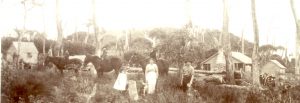
George Wainwright senior, Matilda Wainwright and children at Mount Cameron West (Preminghana) c1900. Courtesy of Kath Medwin.
These problems aside, it seems odd that the pragmatic Van Diemen’s Land Company (VDL Co), which later added fur hunting to its income stream, didn’t cotton on to the live tiger trade. They could have followed the example of George Wainwright senior, who sold a Woolnorth tiger to Fitzgerald’s Circus in 1896.[6] In 1900, for example, 22 thylacines were killed on Woolnorth, a potential income of more than £100 had the animals been taken alive. Even when, later, four living Woolnorth tigers were sold, the money stayed with the employees, with the VDL Co not even taking a commission. (It should be noted that four young tigers caught by Walter Pinkard on Woolnorth in 1901 were not accounted for in bounty payments.[7] It is possible that they were sold alive—but there are no records of a sale or even correspondence about the animals. Their fate is unknown.)
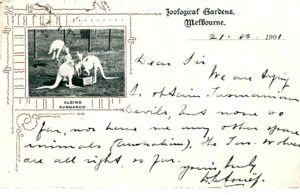
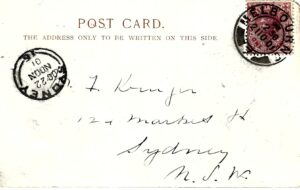
William Le Souef to Kruger, 22 October 1901: ‘The Tasmanian Wolves are all
right, so far’. Did he get them from Woolnorth? Postcard courtesy of Mike Simco.
The VDL Co’s failure to exploit the live trade for its perceived arch enemy can possibly be explained by the tunnel vision of its directors and departing Tasmanian agent and the inexperience of his successor. James Norton Smith resigned as local manager in 1902. His replacement, Scotsman Andrew Kidd (AK) McGaw, harnessed Norton Smith’s 33-year corporate knowledge by re-engaging him as farm manager. It would not have been easy for McGaw to learn the ropes in a new country, among business associates cultivated by his predecessor, and the re-engagement of Norton Smith as his second allowed him to transition into the manager position. As would be expected, McGaw stamped his authority on the agency by criticising some of Norton Smith’s policies and distancing himself from them.[8] Ahead of Ernest Warde’s engagement as ‘tigerman’, the VDL Co’s shepherd at Mount Cameron West, he scrapped Norton Smith’s recent bounty incentive scheme of £2 for a tiger killed by a man out hunting with dogs.
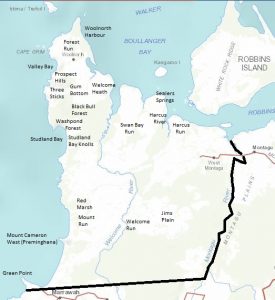
Woolnorth, showing main property features and the original boundary. Base map courtesy of DPIPWE.
After Warde’s departure in 1905, the tiger snares at Mount Cameron and Studland Bay were checked intermittently. Woolnorth overseer Thomas Lovell killed a tiger at Studland Bay in 1906, but the number of tigers and dogs reported on the property was now negligible.[9] This reflected the statewide situation, with only eighteen government thylacine bounties being paid in 1907, and only thirteen in 1908.[10]
However, the value of live tigers continued to climb as they became rarer. The first documented approach to the VDL Co for live tigers came in July 1902 from AS Le Souef of the Zoological Gardens in Melbourne, who offered £8 for a pair of adults and £5 for a pair of juveniles. He also wanted devils and tiger cats, in response to which George Wainwright junior supplied two tiger cats (spotted quolls, Dasyurus maculatus).[11] Given the tiger’s reputation as a sheep killer, native animal farming might have been a hard sell to the directors, and the company continued to use necker snares which were generally fatal to thylacines. What price would it take to change that behaviour? In July 1908 McGaw read a newspaper advertisement:
‘WANTED—Five Tasmanian tigers, handsome price for good specimens. Apply Beaumaris, Hobart.’[12]
He discovered that the proprietor of the private Beaumaris Zoo at Battery Point, Mary Grant Roberts, wanted a pair of living tigers immediately to freight to the London Zoo.[13] The Orient steamer Ortona was departing for London at the end of the month. She offered McGaw £10 for a living, uninjured pair of adults. Roberts hoped to secure the tiger caught recently by George Tripp at Watery Plains, but felt that she was competing for live captures with William McGowan of the City Park Zoo, Launceston, who advertised in the same month.[14] Eroni Brothers Circus was also in the market for living tigers.[15]
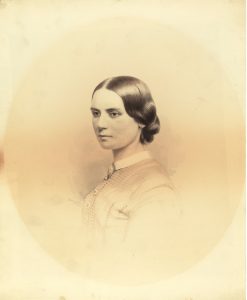
A young Mary Grant Roberts, from NS823/1/69 (Tasmanian Archive and Heritage Office).
Almost as Roberts made her offer, George Wainwright junior tracked a tiger at Mount Cameron West, but it evaded capture.[16] In the meantime Roberts was able to secure her first thylacine from the Dee River.[17]
Almost a year passed before the chance arose for the VDL Co do business, when in May 1909 Wainwright retrieved a three-quarters-grown male tiger uninjured from a necker snare.[18] Perhaps not appreciating the tiger’s youth, Roberts offered £5 plus the rail freight from either Burnie or Launceston. She wanted the animal delivered to her in Hobart within ten days in order to ship it to the London Zoo on the Persic. It would thereby replace one which had died of heat exhaustion in transit to the same destination a few months earlier.[19]
However, the overseer of a remote stock station could not meet that deadline. The delay came with a bonus—the capture of three more members of the first tiger’s family, his sisters and mother.[20] Bob Wainwright recalled his stepfather Thomas Lovell and brother George placing the animals in a cage. There was also a familiar story of tigers refusing to eat dead game: ‘They had to catch a live wallaby and throw it in, alive, and then they [the thylacines] killed it’.[21] With McGaw continuing to act as intermediary between buyer and supplier, a price of £15 was settled on for the family of four.[22]
Roberts and McGaw communicated as social equals, but their social inferiors—hunters, stockmen and an overseer—were not named in their correspondence. This made for frustrating reading when Roberts discussed hunters (‘the man’) with whom she was dealing over live tigers. She had been expecting to receive two young tigers from a Hamilton hunter for her own zoo, but these had now died, causing her to reconsider her plans for the Woolnorth family.[23]
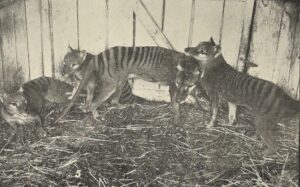
The mother thylacine (centre) and her three young captured at Woolnorth in 1909. W Williamson photo from the Tasmanian Mail, 25 May 1916, p.18.
It wasn’t until the first week in July 1909 that the auxiliary ketch Gladys bore the crate of thylacines to Burnie, where they began the train journey to Hobart.[24] A week later they were said to be thriving in captivity.[25] Roberts was so pleased with the animals’ progress that after eight months she sent a postal order to Lovell and Wainwright as a mark of appreciation. She was impressed with the mother’s devotion to her young, believing that the death of the two Hamilton cubs was attributable to their mother’s absence.[26] However, money was becoming a concern. Buying all the tigers’ feed from a butcher was expensive, and when she received a potentially lucrative order for a tiger from a New York Zoo, she found the cost of insuring the animal over such a long journey prohibitive. On 1 March 1910 she ‘very reluctantly’ broke up the family group by dispatching the young male to the London Zoo. ‘I am keeping on the two [other juveniles]’, she wrote, ‘in the hope that they may breed, and the mother all along has been very happy with the three young ones’.[27]
Roberts was now offering £10 per adult thylacine—but there was none to sell at Woolnorth. Seventeen months later she paid Power £12 10s for his large tiger from Tyenna, and scored £30 shipping to London the last of the three young from the 1909 family group.[28] Her tiger breeding program was over, probably defeated by economics—but what might have been the rewards for perseverance? Perhaps she would have been the greatest tiger farmer of all.
[1] See, for example, ‘Commercial’, Mercury, 5 August 1890, p.2; Sarah Mitchell diary, 9 June 1890, RS32/20, Royal Society Collection (University of Tasmania Archives).
[2] See, for example, ‘Trappers fined’, Advocate, 22 October 1943, p.4.
[3] ‘Direct communication with the west coast initiated’, Mercury, 1 September 1932, p.12.
[4] G Weindorfer and G Francis, ‘Wild life in Tasmania’, Journal of the Victorian Naturalists Society, vol.36, March 1920, p.159.
[5] Lewis Stevenson, interviewed by Bob Brown, 1 December 1972 (QVMAG).
[6] ‘Circular Head notes’, Wellington Times and Agricultural and Mining Gazette, 25 June 1896, p.2.
[7] Walter Pinkard to James Norton Smith, 19 July 1901, VDL22/1/27 (TAHO).
[8] In Outward Despatch no.46, 4 January 1904, p.366, McGaw criticised Norton Smith for not doing more to arrest the encroachment of sand at Studland Bay and Mount Cameron (VDL7/1/13).
[9] Woolnorth farm diary, 30 September 1906 (VDL277/1/34). This VDL Co bounty was not paid until the following year (December 1907, p.95, VDL129/1/4). C Wilson was paid for killing two dogs found worrying sheep in 1906 (December 1906, p.58, VDL129/1/4 (TAHO).
[10] See thylacine bounty payment records in LSD247/1/3 (TAHO).
[11] AS Le Souef to James Norton Smith, 11 July 1902; Walter Pinkard to James Norton Smith, 4 August 1902, VDL22/1/28 (TAHO).
[12] ‘Wanted’, North Western Advocate and the Emu Bay Times, 1 July 1908, p.3.
[13] For Roberts, see Robert Paddle, ‘The most photographed of thylacines: Mary Roberts’ Tyenna male—including a response to Freeman (2005) and a farewell to Laird (1968)’, Australian Zoologist, vol.34, no.4, January 2008, pp.459–70.
[14] In ‘Wanted to buy’, Mercury, 18 July 1908, p.2, McGowan asked for tigers ‘dead or alive’. He had also advertised for ‘tigers … good, sound specimens, high price; also 2 or 3 dead or damaged specimens’ in the previous year (‘Wanted’, Mercury, 21 June 1907, p.2). George Tripp’s tiger must have died before it could be sold alive, since he claimed a government bounty for it (no.35, 25 July 1908, LSD247/1/3 [TAHO]).
[15] See, for example, ‘Wanted’, North Western Advocate and the Emu Bay Times, 7 March 1908, p.6.
[16] Thomas Lovell to AK McGaw, 17 July 1908, VDL22/1/34 (TAHO).
[17] ‘The Tasmanian tiger’, Mercury, 7 October 1908, p.4.
[18] Thomas Lovell to AK McGaw, 24 May 1909, VDL22/135 (TAHO). This thylacine was originally thought to be a young female, but McGaw later stated that it was a young male.
[19] Mary G Roberts to AK McGaw, 31 May 1909, VDL22/1/35 (TAHO).
[20] Thomas Lovell to AK McGaw, 1 June 1909, VDL22/1/35 (TAHO).
[21] Bob Wainwright, 86 years old, interviewed in Launceston, 27 October 1980.
[22] AK McGaw to Mary G Roberts, 9 June 1909, VDL52/1/29; Mary G Roberts to AK McGaw, 10 June 1909, VDL22/1/35 (TAHO).
[23] Mary G Roberts to AK McGaw, 21 June 1909, VDL22/1/35 (TAHO).
[24] AK McGaw to Mary G Roberts, 7 July 1909, VDL52/1/29 (TAHO); ‘Stanley’, North Western Advocate and the Emu Bay Times, 6 July 1909, p.2.
[25] W Roberts to AK McGaw, 15 July 1909, VDL22/1/35 (TAHO).
[26] In May 1912 she received two young tigers from buyer EJ Sidebottom in Launceston, paying him £20 in the belief that they were adults. They died three days later (Mary Grant Roberts diary, 6, 7 and 10 May 1912, NS823/1/8 [TAHO]).
[27] Mary G Roberts to AK McGaw, 14 March 1910, VDL22/1/36 (TAHO).
[28] Mary Grant Roberts diary, 12 August, 26 September and 24 December 1911, NS823/1/8 (TAHO).
by Nic Haygarth | 17/12/16 | Circular Head history, Story of the thylacine

The Wainwrights at Mount Cameron West (now returned to the Aboriginal people, as Preminghana) during the late 1890s. Sunday best is adopted for the photographer. The girl standing at front beside her parents Matilda and George is probably May, the boys on horseback are probably George, Dick and Harry. Photo courtesy of Kath Medwin.
In 1889 Van Diemen’s Land Company (VDL Co) local agent James Norton Smith advertised for ‘a trustworthy man to snare tigers [thylacines or Tasmanian tigers], kangaroo, wallaby and other vermin at Woolnorth’, the company’s large grazing property at Cape Grim. The annual wage was £30 plus rations and a £1 bounty for each thylacine killed.[1] Applications came from Tasmanian centres as far afield as Branxholm in the north-east and New Norfolk in the south. One, written on behalf of her husband, came from Rachel Nichols of Campbell Town. She was the mother of then eleven-year-old Ethelbert (Bert) Nichols, the future hunter, Overland Track cutter, highland guide and Lake St Clair Reserve ranger.[2]
However, none of these applicants got the job. The man chosen as ‘tigerman’, as the position was known within the VDL Co, was George Wainwright senior, who arrived ‘under a cloud’ as George Wilson and departed in 1903 when convicted of receiving stolen skins.[3] Was he a relation of Woolnorth overseer James Wilson, or how was he selected for the job?[4] And what was a tigerman anyway?
George Wainwright was born in Launceston in 1864, and seems to have a not untypical upbringing for the poorly educated child of an ex-convict father, featuring family breakdown, petty crime, shiftlessness and suggestions of poverty.[5] As a young adult he measured only 162 cm (5 foot 3 inches), with a dark complexion and dark curly hair. The scar under his chin may have the result of rough times on the streets of Launceston.[6] Food may have been scarce. At thirteen he faced court with another boy on a charge of stealing apples (the case was dismissed for lack of evidence).[7] In 1883, his employer, Launceston butcher Richard Powell, had the nineteen-year-old arrested on warrant (that is, in absentia) on a charge of breaching the Master and Servant Act.[8] He had run off to Sydney, describing himself as a cook.[9]
George had returned to Launceston by October of that year, when his mother, now known as ‘Mrs T Barrett’ (née Caroline Hinds or Haynes or Hyams), ran a public notice instructing clergymen not to marry her son to anyone, he being under age.[10] Presumably George had Matilda Maria Carey (1863–1941)—or her pregnancy—in mind, because the couple were soon united, and soon separated.[11] In 1885 Matilda prosecuted George for deserting her and George junior, having not sent her any money for six months. It was revealed in court in Melbourne that George had recently been a grocer’s assistant, but now was working in a Brunswick (Melbourne) brick yard. Matilda Wainwright was then living with her father-in-law William Wainwright in Launceston. She claimed he showed her little sympathy, having sold all her furniture and told her to seek a living for herself. George Wainwright was freed on agreeing to pay her 10 shillings per week.[12]
Interestingly, in Victoria he was known to police as George Brown, ‘alias Wainwright’.[13] Presumably he returned to Launceston sometime between 1885 and 1889—and changed his name to George Wilson! He may have been the George Wilson who was in Beaconsfield in 1886 and 1887.[14] Perhaps he became a protégé of James Wilson, the Woolnorth overseer, and perhaps that man’s intervention secured Wainwright/Brown/Wilson the tigerman job at Woolnorth. James Wilson had coined the term ‘tigerman’ to describe the Mount Cameron West shepherds in the period 1871–1905. Convinced that thylacines were killing their sheep, the VDL Co gave the Mount Cameron West man the additional job of maintaining a line of snares across a narrow neck of land at Green Point, which was believed to be the predator’s principal access point to Woolnorth. Otherwise, the tigermen were actually standard stockmen-hunters, charged with guarding sheep and destroying competitors for the grass.
George Wilson and his family originally occupied a one-room hut at Mount Cameron West. In 1893 George Wainwright, as he was now known again, apparently told a visitor that he received £2-10 for each thylacine killed—£1 from the VDL Co, £1 from the government and 10 shillings for the skin. In the years 1888–1909 the Tasmanian government paid a bounty on every thylacine carcass submitted to police. However, nobody by the name of Wainwright ever collected a government bounty: in fact only two VDL Co tigermen, Arthur Nicholls and Ernest Warde, personally collected government bounties while working for the company.[15] The thylacine carcasses appear to have been sold through intermediaries, chiefly Stanley merchants Charles Tasman (CT) Ford (1891–99) and (after Ford’s death) William B (WB) Collins (1900–06). Ford, who also drove cattle down the West Coast to Zeehan and bought VDL Co stock, was a regular visitor to Woolnorth.[16]
In 1893 Wainwright had about 60 springer snares set for wallaby, pademelon and brush possum.[17] Ringtails were the dubious beneficiary of technological change, as the commercial manufacture of acetylene or carbide during the 1890s revolutionised ‘spotlighting’. Using an acetylene lamp to spotlight nocturnal animals was a vast improvement on the traditional method of shooting by moonlight, since some animals, especially the ringtail possum and ‘native cat’, were ‘hypnotised’ by the lamp, remaining rooted to the spot. It was not the ideal hunting technique for a grazing run, however, let alone for a solitary shepherd. Usually, two men worked together, one ‘spotting’ the animals with the acetylene lamp, the other shooting them. The lamps which shooters used frightened stock, and sometimes shooters’ dogs ran amok with grazing sheep. More significantly for the hunter, shooting the animal in any other part but the head damaged its pelt. Acetylene fumes were also unpleasant for the hunter, and the battery sometimes gave him an unexpected ‘charge’.
More money was available for a living tiger than a dead one. By Wainwright’s time, thylacines were in demand from zoos. In 1892 James Denny caught one alive at the Surrey Hills and sent it to the Zoological Gardens in Melbourne.[18] In 1896 CT Ford was asked to procure live tigers for a circus. Wainwright obliged by capturing a thylacine alive and sending it into Stanley, where there was ‘a little excitement … to see “the tiger”’ before it was shipped to Sydney.[19] This thylacine capture does not appear in the extant Woolnorth farm journal record (the journal for 1896 is missing) or in any other surviving official records for Woolnorth. Since the animal was not killed, Wainwright received no VDL Co or government reward for it.
In 1897–98 a new hut was built for George and Matilda at Mount Cameron. They would need it. Six children—George, Alf, Dick, May, Harry, Gertrude and Robert—gave them plenty to worry about in such an isolated place. If that was not enough, Matilda was reportedly ‘very ill’ in July 1893 and ‘badly hurt’ in January 1894, while in May 1900 Woolnorth overseer W Pinkard had to fetch medicine for her from Stanley.[20]
By 1900 George and Dick were already showing their prowess as tiger snarers, and one of the Wainwright boys was digging potatoes.[21] With their father sometimes helping out elsewhere on the property, fetching cattle from Ridgley or a stockman from Trefoil Island, the children quickly developed a range of skills which ensured that they could work on the land independently.[22]

George Wainwright’s mugshot, 1903. Courtesy of TAHO.
Wainwright’s imprisonment in 1903 gave them that opportunity. The story of his crime of receiving 298 wallaby, 298 pademelon, 17 tiger cat, 2 domestic cat and 10 brush possum skins stolen from William Charles Wells contains insight into hunting at Mount Cameron West and on Woolnorth generally. Wells was caretaker (hunter-stockman) for a farm at Green Point south of Woolnorth, near where the VDL Co arranged its snares. The owner of the property, Thomas John King, had stayed with Wainwright in the Mount Cameron Hut in July 1902 after fetching the skins from the farm. The skins disappeared overnight after being left outside the hut in a cart. Suspicion fell on Wainwright not only because his was the only hut in the area but because he had previously tried to buy the skins at a price which was refused. Police alleged that in September Matilda Wainwright drove a buggy containing the skins to the port at Montagu to be loaded on the ketch Ariel.[23] It was now close season, so Wainwright wrote telling Stanley storekeeper WB Collins that he was sending down some out-of-season skins and suggesting that he ask the police to let them pass. Wells claimed to have identified 23 of his stolen skins in Collins’ store.[24] Proof that Wainwright was guilty centred on Wells’ identification of an unusually light skin among those Wainwright had sent to market. A search conducted among the skins of three Launceston skin merchants, Lees, Sidebottom and Gardner, revealed only three or four skins matching the one identified by Wells, confirming the distinctiveness of the skin and strengthening the case against Wainwright.[25]
Launceston merchant Robert Gardner testified that he had known Wainwright for 25 years, having employed him when he (Wainwright) was a boy, and that he had done business with him for several years, finding him straightforward and honest. He had bought wallaby skins from Wainwright regularly.[26] Despite this testimonial, Wainwright was given a twelve-month sentence for receiving stolen property. Thirty-nine years old, he died in the Hobart Gaol of heart failure prompted by acute pneumonia only four months into that sentence.[27]
Today a relatively young man’s death in custody would provoke an inquest. However, the harshness of Wainwright’s demise seems in keeping with the harshness of his sentence and the general torpor of working people’s lives more than a century ago. George must have done something right as a hunter and provider, because he left wife Matilda £305—more than ten times his annual stockman’s wage.[28]
Charged with nothing, Matilda Wainwright stayed on as cook at Woolnorth, although only because no one else could be found for the job. ‘I would have preferred anyone else rather than Mrs Wainwright’, new VDL Co agent AK McGaw lamented, ‘and now that she is there I am not altogether satisfied that her influence is for the best. Of course I find her appointment does not answer I will have no hesitation in terminating it’.[29] McGaw had advertised for a married couple to replace the Wainwrights.[30] He effectively got one when the widowed Matilda married the new overseer, Thomas Lovell, while her sons, good workmen, also had a future at Woolnorth. As a woman and mother, remarriage was her only option anyway. George Wainwright junior would carve out his own long career as a VDL Co stockman.
[1] ‘Wanted, at Woolnorth’, Daily Telegraph, 9 August 1889, p.1.
[2] Rachel Nichols to James Norton Smith, 8 August 1889, VDL22/1/19 (Tasmanian Archives and Heritage Office [afterwards TAHO]).
[3] AW McGaw, Outward Despatch no.16, 1 June 1903, p.151, VDL7/1/13 (TAHO); ‘Death of a prisoner’, Mercury, 15 July 1903, supplement p.6.
[4] On the bottom of J Lowe’s application for the job is written in pencil ‘Geo Wilson also’. Everett was the reserve choice: on the back of his application is written ‘If man, at present engaged—not successful will write JL again’. See J Lowe application 9 August 1889 and J Everett application, 19 August 1889, VDL22/1/19 (TAHO).
[5] For William Wainwright (1810–87), see conduct record, CON33-1-90, TAHO website, http://search.archives.tas.gov.au/ImageViewer/image_viewer.htm?CON33-1-90,207,205,F,60, accessed 17 December 2016.
[6] ‘Miscellaneous information’, Victoria Police Gazette, 19 August 1885, p.232.
[7] Birth registration 60/1864, Launceston; ‘Police Court’, Cornwall Chronicle, 7 February 1877, p.3.
[8] ‘Launceston Police Court’, Tasmanian, 22 April 1882, p.432; ‘Launceston Police Court’, Launceston Examiner, 7 February 1883, p.3.
[9] He arrived in Sydney from Launceston on the Esk, 9 February 1883, New South Wales, Australia, Unassisted Passenger Lists, 1826–1922.
[10] Advert, Launceston Examiner, 31 October 1883, p.1.
[11] Marriage registration 677/1883, Launceston. They married 7 November 1883, George William Wainwright was born seven months later, on 12 June 1884, birth registration 371/1884, Launceston. Matilda Maria Carey was born in Launceston, 22 December 1863, registration 23/1864, Launceston.
[12] ‘Wife desertion’, Launceston Examiner, 29 August 1885, p.2.
[13] ‘Miscellaneous information’, Victoria Police Gazette, 19 August 1885, p.232.
[14] ‘Beaconsfield’, Daily Telegraph, 29 May 1886, p.3; ‘Beaconsfield’, Launceston Examiner, 15 January 1887, p.12.
[15] Nicholls: bounties no.289, 14 January 1889, p.127; and no.126, 29 April 1889, p.133, LSD247/1/1. Warde: bounty no.190, 20 October 1904, p.325, LSD247/1/2 (TAHO).
[16] James Wilson to JW Norton Smith, 8 April 1879, VDL22/1/7 (TAHO).
[17] Austin Allom, ‘A trip to the west coast’, Daily Telegraph, 19 August 1893, p.7.
[18] ‘Current topics’, Launceston Examiner, 17 September 1892, p.2.
[19] ‘Circular Head notes’, Wellington Times and Agricultural and Mining Gazette, 25 June 1896, p.2.
[20] Woolnorth Farm Journal, 10 July 1893, VDL277/1/20; 22 January 1894, VDL277/1/21; and 7 May 1900, VDL277/1/25 (TAHO).
[21] Woolnorth Farm Journal, 13 and 14 June, 7 May 1900, VDL277/1/25 (TAHO).
[22] Woolnorth Farm Journal, 22 September 1898, VDL277/1/24; 16 January and 5 March 1899, VDL277/1/25 (TAHO).
[23] ‘Supreme Court’, North Western Advocate and the Emu Bay Times, 14 November 1902, p.2.
[24] ‘Supreme Court’, Mercury, 15 November 1902, p.3.
[25] ‘The Wainwright case’, Examiner, 28 February 1903, p.6.
[26] ‘The Wainwright case’, Examiner, 27 February 1903, p.6.
[27] ‘Death of a prisoner’, Examiner, 15 July 1903, p.6.
[28] ‘Testamentary’, Mercury, 20 October 1903, p.4.
[29] AK McGaw to VDL Co Board of Directors, no.38, 2 November 1903, p.313, VDL7/1/13 (TAHO).
[30] Advert, Examiner 20 May 1903, supplement p.8.



















